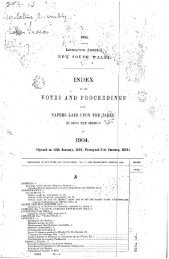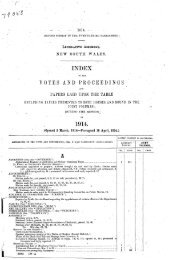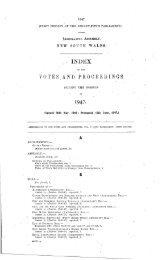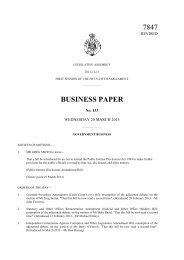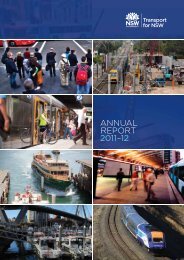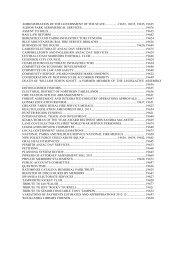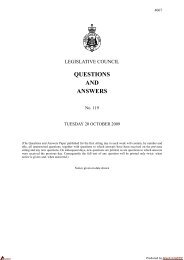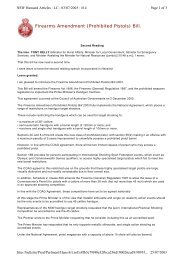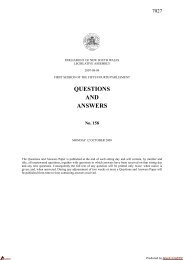Endeavour Energy Annual Performance Report - Parliament of New ...
Endeavour Energy Annual Performance Report - Parliament of New ...
Endeavour Energy Annual Performance Report - Parliament of New ...
Create successful ePaper yourself
Turn your PDF publications into a flip-book with our unique Google optimized e-Paper software.
2 Statement <strong>of</strong> Significant<br />
Accounting Policies<br />
continued<br />
Gains and losses on disposal <strong>of</strong><br />
an item <strong>of</strong> property, plant and<br />
equipment are determined by<br />
comparing the proceeds from<br />
disposal with the carrying amount<br />
<strong>of</strong> property, plant and equipment,<br />
and are recognised in pr<strong>of</strong>it or<br />
loss. When revalued assets are<br />
sold, the amounts included in the<br />
revaluation reserve are transferred<br />
to retained earnings.<br />
System assets<br />
In accordance with NSW Treasury<br />
Accounting Policy TPP07-1 Valuation<br />
<strong>of</strong> Physical Non-Current Assets at<br />
Fair Value system assets are carried<br />
at fair value less accumulated<br />
depreciation and impairment losses.<br />
System assets are considered to be<br />
<strong>of</strong> a specialised nature, and fair value<br />
is estimated using a depreciated<br />
replacement cost method in<br />
accordance with AASB 116 Property,<br />
Plant and Equipment.<br />
A revaluation <strong>of</strong> system assets was<br />
undertaken by an independent<br />
valuer and recognised as at<br />
30 June 2011. System assets were<br />
valued at Optimised Depreciation<br />
Replacement Cost (ODRC). The<br />
ODRC valuation was determined<br />
based on the following approach:<br />
• Establish the current replacement<br />
cost <strong>of</strong> the modern equivalent <strong>of</strong><br />
assets in service at the valuation<br />
date. The concept <strong>of</strong> modern<br />
equivalent assets refers to assets<br />
that would be employed if the<br />
network were to be rebuilt today.<br />
• Depreciate the adjusted<br />
replacement cost to reflect the<br />
remaining effective life <strong>of</strong> the<br />
assets in service; and<br />
• Adjust the current replacement<br />
cost for over-design, overcapacity<br />
and redundant<br />
assets (optimisation).<br />
System assets are revalued at least<br />
every five years, in accordance<br />
with NSW Treasury Accounting<br />
Policy TPP07-1 Valuation <strong>of</strong> Physical<br />
Non-Current Assets at Fair Value.<br />
The frequency <strong>of</strong> valuations is<br />
considered appropriate given the<br />
nature, size and geographical spread<br />
<strong>of</strong> system assets, and annual fair<br />
value assessments.<br />
Non-system land and buildings<br />
Following initial recognition at<br />
cost, non-system land and building<br />
assets are carried at fair value less<br />
accumulated depreciation and<br />
impairment losses, in accordance<br />
with NSW Treasury Accounting Policy<br />
TPP07-1 Valuation <strong>of</strong> Physical Non-<br />
Current Assets at Fair Value.<br />
Non-system land and buildings are<br />
subject to independent valuation<br />
on a cyclical basis over a three year<br />
period. The carrying amount <strong>of</strong><br />
non-system land and building assets<br />
is reviewed between independent<br />
valuations, to ensure the carrying<br />
amount does not differ materially<br />
from fair value.<br />
A revaluation <strong>of</strong> non-system land<br />
and buildings was undertaken by an<br />
independent valuer and recognised<br />
as at 30 June 2011. The valuations<br />
were based on market-based<br />
evidence in accordance with AASB<br />
116 Property, Plant and Equipment.<br />
Other plant and equipment<br />
In accordance with NSW Treasury<br />
Accounting Policy TPP07-1 Valuation<br />
<strong>of</strong> Physical Non-Current Assets at<br />
Fair Value depreciated historical<br />
cost with respect to non-specialised<br />
assets is considered an acceptable<br />
surrogate for fair value, with any<br />
difference unlikely to be material.<br />
Accordingly, other plant and<br />
equipment are carried at fair value<br />
less accumulated depreciation and<br />
any impairment in value.<br />
Property, plant and equipment in<br />
the course <strong>of</strong> construction<br />
Property, plant and equipment in the<br />
course <strong>of</strong> construction are carried at<br />
cost, less any recognised impairment<br />
loss. Depreciation <strong>of</strong> these assets<br />
commences when the assets are<br />
ready for their intended use.<br />
Depreciation<br />
Depreciation is recognised in pr<strong>of</strong>it<br />
or loss on a straight-line basis over<br />
the estimated useful lives <strong>of</strong> each<br />
part <strong>of</strong> an item <strong>of</strong> property, plant and<br />
equipment, since this most closely<br />
reflects the expected pattern <strong>of</strong><br />
consumption <strong>of</strong> the future economic<br />
benefits embodied in the assets.<br />
Land is not depreciated.<br />
Estimated useful lives are as follows:<br />
Years<br />
System assets 7–60<br />
Buildings 40<br />
Plant and equipment 4–10<br />
Depreciation methods, useful lives<br />
and residual values are reviewed at<br />
each financial year-end and adjusted<br />
if appropriate.<br />
Capitalisation Policy<br />
Property, plant and equipment assets<br />
below $1,000 are expensed in the<br />
year <strong>of</strong> acquisition or construction.<br />
(l) Non-current assets<br />
held for sale<br />
Non-current assets and disposal<br />
groups are classified as held for<br />
sale and measured at the lower<br />
<strong>of</strong> their carrying amount and fair<br />
value less costs to sell, if their<br />
carrying amount will be recovered<br />
principally through a sale transaction<br />
as opposed to use. Once classified<br />
as held for sale, depreciation and<br />
amortisation ceases. For an asset<br />
or disposal group to be classified<br />
as held for sale, it must be available<br />
for immediate sale in its present<br />
condition and its sale must be<br />
highly probable.<br />
<strong>Endeavour</strong> <strong>Energy</strong> <strong>Annual</strong> <strong>Performance</strong> <strong>Report</strong> 2010–11<br />
57



